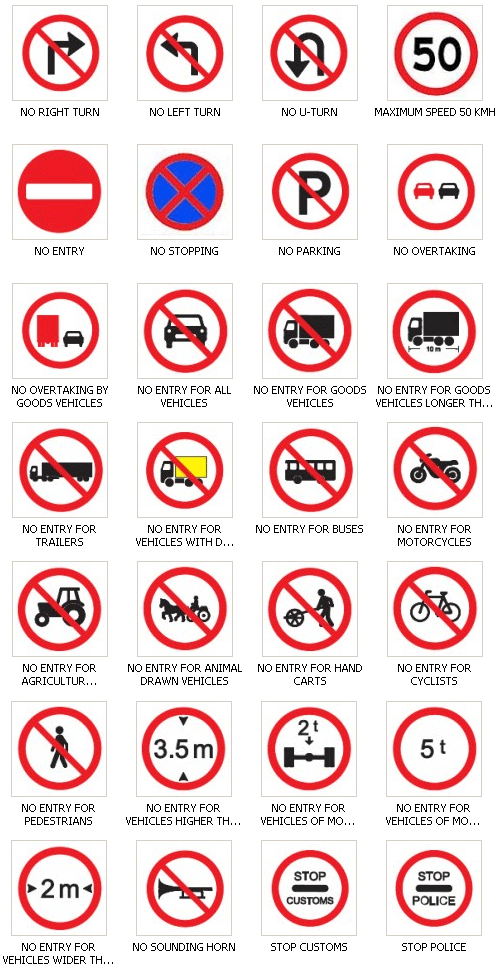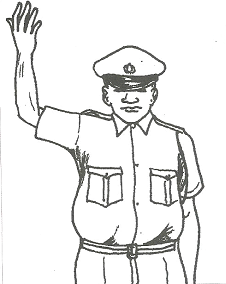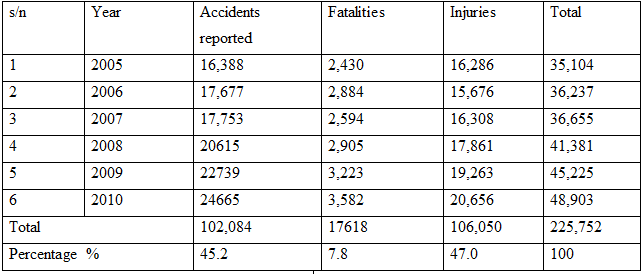CIVICS FORM ONE :TOPIC 7 ROAD SAFETY EDUCATION
Importance of Road/Traffic Signs
The Meaning of Road or Traffic Signs
Explain the meaning of road or traffic signs
A road
is a man-made pathway which enables vehicles, pedestrians, and even
animals to move from one place to another. There are three types of
roads - earth, gravel and tarmac roads.
Road safety
refers to the general state of being safe from danger when using roads
to move from one place to another. Roads are sometimes categorised as
main and feeder (minor) roads. Road safety is the situation in which
road users are free from risks and accidents.
Interpretation of Road or Traffic Signs
Give correct interpretation of road or traffic signs
Road
signs are international symbols which tell road users how to use the
road properly. Some examples are warnings, like speed limit, a bending
in the road, pedestrian or cattle crossings. The most common road signs
are traffic lights, stop signs, no entry and speed bumps.
Road
signs carry messages for road users through symbols, shapes and colors.
Thus, road signs give instructions to road users so that the roads can
be used properly and safely. Below are some of the road signs, followed
by their interpretation.
Prohibitory signs

Mandatory signs

Dangerous mandatory signs

Informative signs

Police signals to drivers
A traffic policeman waving for vehicles coming from the side

A traffic policeman waving for vehicles coming from the front

A traffic policeman

Categories of road signs
There are four types of road signs — prohibitory, mandatory, danger warning and informative signs.
Prohibitory and mandatory sighs
These
signs help control the speed of road users. There are two types: those
which allow (permit) and those which prohibit (limit). Those which
permit are usually colored green while those which prohibit are in red.
They are also enclosed in circles or octagons.
Danger warning signs
These
signs warn road users to take proper measures to prepare for the danger
ahead. They comprise of pictures and diagrams which show the dangers,
e.g. a double bend warning motorists to slow down. The useful shape is
triangles, and the color used is amber.
Informative signs
These
signs are drawn on the road surface or fixed on a post by the roadside
to give road users important information on how to use the road. They
are also enclosed in rectangles, and a blue color is used for the
information.
Exercise 1
1. What is a road sign?
Exercise 2
2. There are three useful shapes for types of road signs:
- Circle or octagon is for_____
- Triangle is for _____
- Rectangle is for ______
Exercise 3
3. Give five examples of warning signs
Exercise 4
4. Mention colours and explain how they are used on the road
Exercise 5
5. We use road signs for the sake use of roads _______ (True/False?)
Importance of Obeying Road or Traffic Signs
Explain the importance of obeying road or traffic signs
Road
signs are very important because they help prevent accidents as they
give information to road users about what lies ahead. They also help to
regulate the speed of road bends, vehicles and avoid traffic
congestion, especially where roads intersect.
Additionally,
road signs provide equal rights to road users and equal access to use
the roads, e.g. cattle and pedestrian crossing signs. They also tell
drivers how to use the roads properly for the safety of other road
users. Lastly, they reduce the burden of using many traffic police to
control the traffic, e.g. traffic lights may replace traffic police.
The Consequences of Failure to Observe Road Traffic Signs
Explain the consequences of failure to observe road traffic signs
A
number of consequences can be seen if one fails to observe road signs.
For example,
- occurrence of road accidents if road users do not use the roads properly and unnecessary traffic jams, especially where roads intersect as there won’t be any command signs.
- Also, there will not exist equal rights for road users, e.g. big vehicles would, for instance, dominate the use of the roads and deny small vehicles and other road user’s equal access to the roads.
- We may witness an increase in the loss of lives and damage to property, not only to vehicles and people who use the roads but also to pedestrians or property that may be hit by overturning cars.
- Family suffering may also be witnessed. This is due to the death or permanent disability of victims of accidents. Such disabled persons may be unable to work, hence causing the economic decline of the family.
- In
addition to that, the government, people and organisations will have to
spend large amounts of money on medical resources to treat not only the
road accident victims but also in maintenance of the damaged vehicles
or in buying new ones. Accidents would also cause a delay in arriving at
our destinations, e.g. school, workplaces, church, mosque or home
Causes of Road Accidents
Road accidents are unpleasant or unusual events that happen on or along the road unexpectedly and cause damage, fatalities (killing of people) or injuries. They take many forms — A car can crash, knocking down road poles due to brake failure, or a driver can lose control, knocking down pedestrians or animals crossing the road.Causes of Road Accidents
Identify causes of road accidentsRoad accidents are common in most countries in the world. However, in Africa, including Tanzania, the number of road accidents is increasing everyday due to the huge increase in the number of vehicles. The major causes of road accidents in Tanzania, however, are as follows:- Reckless and inappropriate driving — speed being the main factor, since fast-moving cars are sometimes uncontrollable.
- Drunkenness — driving while drunk will always result in loss of control by drivers, causing accidents.
- Failure to observe or ignorance about road signs.
- Traffic lights not working due to power cuts off.
- The corrupt practice by the driving licence issuing authorities (who offer licences to unqualified and incompetent drivers).
- Poor road quality, especially in developing countries, where most of the main roads are narrow, rough and full of potholes.
- Sudden stopping of vehicles on main roads, loading and unloading of passengers from buses in the middle of the road at undesignated bus stops.
- Driving mechanically unfit vehicles and unlit vehicles at night.
- Lack of awareness of road users about road safety and traffic discipline.
- Over-confidence which may lead to taking risks while driving.
- Lack of policy enforcement or standard procedures that are observed by the traffic police, some of whom are corrupt.
- Physical and mental illness of workers/drivers, for example, heart diseases, diabetes or depression.
- Lack of motivation on the job. Drivers of commuter buses are forced to rush so as to collect enough money, which leads to frequent accidents.
- Weather conditions: if the weather is not conducive, the roads that are not tarmacked may get badly damaged.
- Driving
for a long time without resting, such that the driver is likely to fall
asleep while driving, e.g. long safari buses and cargo lorries.
The Magnitude of Road Accidents in Tanzania
Assess the magnitude of road accidents in TanzaniaBelow are possible causes of road accidents in Tanzania according to the police records from the traffic police records, Dar es Salaam, Tanzania from 2005 to 2010.Statistics for the magnitude of road accidents in Tanzania do not give the exact number. Although no one can deny the fact that Tanzania is currently experiencing a rapid increase in the number of road accidents due to the reasons mentioned above, there is always incomplete data on fatalities, injuries and destruction because the police are not informed about all the accidents that take place in the country. Normally, only fatal accidents are reported. Perhaps, this is because people are ignorant about reporting accidents or probably they are afraid of the results of reporting accidents, especially when they are the ones who caused them.The statistical record of road accidents, from 2005 to 2010, shows the magnitude of road accidents in Tanzania (see table 9.2). The total number of reported accidents increased by almost 51% - from 2005 to 2010. The total number of fatalities increased each year from 2005 to 2010, but declined by approximately 7% in 2007.Table 9.3 shows accidents by vehicle type from 1993 to 1997. The distribution highlights that private cars, ‘daladala’ and pick-ups were the most involved in road accidents. The high number of cars clearly reflects their increase in number throughout the country in recent years and the pressure on conm-iuter buses (daladala) drivers to achieve daily targets. This may well contribute to their high involvement in accidents. Furthermore, tables 9.4 and 9.5 show the deaths and injuries due to road traffic accidents in 2000-2005. Lastly, tables 9.6 and 9.7 show the deaths and injuries ratio, and the top-five regions for road accidents in Tanzania mainland 2009-2010, respectively as recorded by the traffic police headquarters.Road accidents in Tanzania (2005 — 2010)Source: Traffic police records (Headquarters)
Consequences of road accidents
There are a number of consequences of road accidents that one may witness. For example, travelers are delayed and children became orphans due to the death of their parents in accidents. Hence, children face a lot of suffering. Some of them end up as street children while other people and livestock die or face permanent disabilities. A lot of money is spent on treating victims and in repairing or replacing the damaged vehicles and other property.Prevention of Road Accidents
Road accidents may be prevented in different ways. For instance, all road users should be aware of traffic rules and how to use them accordingly.Ways of Preventing Road Accidents
Explain ways of preventing road accidents
This can be done by providing road safety education to all road users.- Drivers should also be competent in interpreting road signs and follow their instructions properly.
- Traffic regulations and law enforcement departments must work efficiently.
- Road signs should be put on the roads, and no corrupt behaviour should be done to the traffic police and other authorized personnel.
- Drunkenness of drivers/road users should be prohibited and severe punishments should be put in place for negligent drivers.
- The government and the communities/institutions should frequently and thoroughly maintain the roads including the drainage systems to prevent the overflow of water, and they should check on unlawful building near the roads.
- There should be regular checks on licences, the physical and mental capabilities of drivers and the road worthiness of vehicles.
- Working hours for drivers should be set so that drivers can get an ample time to rest, and defective motor vehicles should not be allowed on the roads.
- The government should make road safety laws/regulations and make sure they are implemented and enforced. Punitive fines for law violators must be introduced and effected.
- Lastly, all road users must discipline themselves to use the roads properly. This could be easily implemented through provision of public education on road safety.



No comments